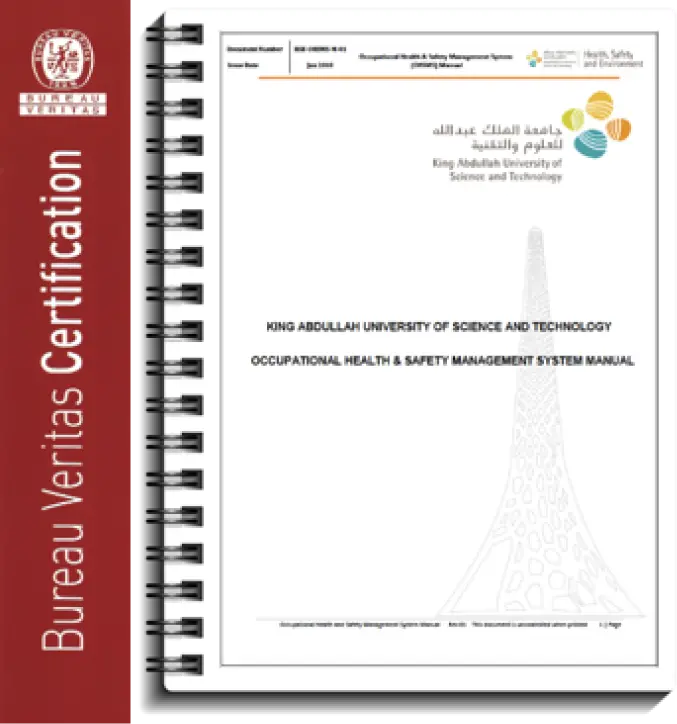




Quick Links:


The Occupational Health and Safety Management System (OHSMS) is a safety governance tool that facilitates the implementation of the Health, Safety, and Environment Policy at KAUST, which aids in fostering a safe and healthy place to work, learn and live.
Implementing the OHSMS was a strategic and operational decision, and its success relies on leadership, commitment, and participation from all organizational levels in KAUST. It provides safety governance, a set of management practices, and decision rights that administer and control how occupational health and safety risks are evaluated, reduced, and managed. KAUST recognizes that an effective safety management system is critical to the success of KAUST and improves its overall safety culture.
The OHSMS is ISO 45001:2018 certified. ISO 45001 is an international standard for health and safety at work developed by national and international standards committees independent of government. KAUST was the first University in the Kingdom to achieve this prestigious recognition. The aim and intended outcomes of the OHSMS are to prevent work-related injury and ill health to workers and to provide safe and healthy workplaces.


KAUST has issued a Health, Safety, and Environment (HSE) Policy which provides the intentions and direction of KAUST related to the HSE, as formally expressed by the Executive Leadership. The ultimate aim of the policy is to prevent work-related injury and ill health to workers and to provide a safe and healthy workplace.
The Document and record Control Procedure provides a framework to ensure control over the creation, approval, review, distribution, and usage of documents used in the OHSMS.
The Audit and Inspection Procedure aims to describe how KAUST will manage the implementation of the OHSMS to verify its effectiveness of the OHSMS.
The Management of Nonconformities and Corrective Actions Procedure describes how nonconformities to the OHSMS will be identified, reported, and corrective actions implemented, as well as the records required. This is the key document that reflects a continual improvement of health and safety performance year on year.
The Operational Control Procedure defines the process of determining, documenting, and conducting control of operations in KAUST using the hazard control hierarchy to control significant hazards.
The primary objective of the Communication, Participation, and Consultation Procedure is to document how the OHSMS manages related internal communication and the communication held with external parties. In addition, this procedure details the health and safety meetings hierarchy and information flow within the organization.
Training is required for staff and contractors who manage health and safety risks at KAUST to ensure the goals identified in HSE Policy are achieved. As of 2019, the staff is only required to complete the Orientation training (Annual refresher training is available online). This module covers all operational health and safety control requirements. For more information on Training, please click here to visit the online training portal.
The Legal and Other Requirements Procedure aims to provide a system for identifying the safety and health-related regulation that applies to all core operations and activities of KAUST. This Procedure also guides the monitoring and evaluating of compliance with applicable regulatory requirements.
The Management Review Procedure describes the type, frequency, and level of management review required to evaluate the suitability and effectiveness of the OHSMS and ensure its continual improvement.
The Hazard Identification and Risk Assessment Procedure aims to define the criteria for conducting safety and health risk identification and assessment. In addition, it requires establishing control for risks that may affect the health and safety of workers, visitors, and other people within the scope of the OHSMS.
The Incident and Near Miss Reporting Procedure describes the process for reporting and investigating incidents and near misses. The OHSMS adopts the KAUST Emergency Management plan to establish the responsibilities and organizational structure for emergencies impacting the KAUST campus or the community.